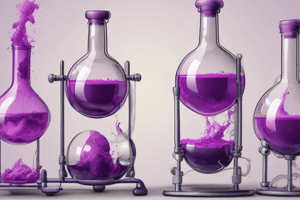Podcast
Questions and Answers
What is the primary aim of studying redox titrations?
What is the primary aim of studying redox titrations?
- To identify only reducing agents
- To evaluate temperature effects on reactions
- To understand principles of oxidation-reduction reactions (correct)
- To determine the weight of oxidizing agents
Which of the following best describes an oxidizing agent?
Which of the following best describes an oxidizing agent?
- A neutral substance that does not participate in a reaction
- A substance that loses electrons during a reaction
- A substance that gains electrons during a reaction (correct)
- A substance that catalyzes chemical reactions
In redox titration, what is primarily determined during quantitative analysis?
In redox titration, what is primarily determined during quantitative analysis?
- The concentration of oxidizing or reducing agents (correct)
- The color change of the solution
- The temperature at which the reaction occurs
- The physical state of reactants
What is a critical competency gained from understanding redox titrations?
What is a critical competency gained from understanding redox titrations?
Which of the following is an example of a reducing free element?
Which of the following is an example of a reducing free element?
How can stoichiometric principles be applied in redox titrations?
How can stoichiometric principles be applied in redox titrations?
What limitation must be assessed when using redox titration methods?
What limitation must be assessed when using redox titration methods?
Which of the following compounds is primarily identified in the determination of peroxides during redox titrations?
Which of the following compounds is primarily identified in the determination of peroxides during redox titrations?
What is the purpose of substances that reduce Fe+3 to Fe+2?
What is the purpose of substances that reduce Fe+3 to Fe+2?
Which of the following anions can be determined collectively under the same category?
Which of the following anions can be determined collectively under the same category?
Which reagent is used in the determination of moisture content?
Which reagent is used in the determination of moisture content?
What is the role of the Zimmermann reagent during titration of ferrous salts?
What is the role of the Zimmermann reagent during titration of ferrous salts?
What compounds are determined under the analysis of mixtures?
What compounds are determined under the analysis of mixtures?
What type of compounds can be determined by analyzing halides and chlorate?
What type of compounds can be determined by analyzing halides and chlorate?
How can metallic iron be determined in a laboratory setting?
How can metallic iron be determined in a laboratory setting?
Which class of cations can be determined through the formation of insoluble oxalates?
Which class of cations can be determined through the formation of insoluble oxalates?
What is the product of the reduction of Fe3+ by SnCl2?
What is the product of the reduction of Fe3+ by SnCl2?
Which method uses zinc as a reducing agent for Fe3+?
Which method uses zinc as a reducing agent for Fe3+?
In the iodometric determination of iron, which substance is added to increase I− concentration?
In the iodometric determination of iron, which substance is added to increase I− concentration?
What color change indicates the endpoint in a direct titration of iron with titanous chloride using methylene blue?
What color change indicates the endpoint in a direct titration of iron with titanous chloride using methylene blue?
Which of the following is an oxidant that can oxidize Fe2+ to Fe3+?
Which of the following is an oxidant that can oxidize Fe2+ to Fe3+?
What is the byproduct when Fe3+ is oxidized by KClO3?
What is the byproduct when Fe3+ is oxidized by KClO3?
Which method uses amalgamated zinc as a reducing agent?
Which method uses amalgamated zinc as a reducing agent?
What is the equilibrium potential (E°) for the Fe3+/Fe2+ system?
What is the equilibrium potential (E°) for the Fe3+/Fe2+ system?
What is the first step in determining the amount of oxidizing substances using oxalic acid?
What is the first step in determining the amount of oxidizing substances using oxalic acid?
In the determination of soluble oxalates, which reagent is used along with sulphuric acid?
In the determination of soluble oxalates, which reagent is used along with sulphuric acid?
What happens to the reaction rate when determining soluble oxalates after the initial phase?
What happens to the reaction rate when determining soluble oxalates after the initial phase?
Which ion does not participate in the iodometric determination of anions?
Which ion does not participate in the iodometric determination of anions?
What is the purpose of back titration in the analysis of oxalic acid?
What is the purpose of back titration in the analysis of oxalic acid?
What is produced when soluble sulphides react with iodine in the titration method?
What is produced when soluble sulphides react with iodine in the titration method?
Which of the following anions requires a known excess of thiosulfate for its determination?
Which of the following anions requires a known excess of thiosulfate for its determination?
During the titration with KMnO4, the presence of which ion leads to a color change indicating the end point?
During the titration with KMnO4, the presence of which ion leads to a color change indicating the end point?
What is produced when chlorate (ClO3−) reacts with iodine and acid?
What is produced when chlorate (ClO3−) reacts with iodine and acid?
Which compound is a product of hypochlorite (ClO−) reacting with iodide ions in an acidic solution?
Which compound is a product of hypochlorite (ClO−) reacting with iodide ions in an acidic solution?
What role does starch play in the determination of halides?
What role does starch play in the determination of halides?
What is one use of N-chlororganic compounds in water treatment?
What is one use of N-chlororganic compounds in water treatment?
In the combustion method involving oxygen, what facilitates the combustion of the compound?
In the combustion method involving oxygen, what facilitates the combustion of the compound?
Which of the following is a byproduct when chlorine from bleaching powder reacts with acetic acid?
Which of the following is a byproduct when chlorine from bleaching powder reacts with acetic acid?
At what temperature is combustion typically completed in the oxygen flask method?
At what temperature is combustion typically completed in the oxygen flask method?
What is the initial reactant in the iodometric determination of hypochlorite?
What is the initial reactant in the iodometric determination of hypochlorite?
What reagent is used to analyze acetic acid in a mixture?
What reagent is used to analyze acetic acid in a mixture?
Which compound undergoes reaction with I2 in the analysis of mixtures?
Which compound undergoes reaction with I2 in the analysis of mixtures?
What is the primary method for determining the concentration of salicylic acid in a mixture?
What is the primary method for determining the concentration of salicylic acid in a mixture?
In the context of the mixture of ferrous oxalate and oxalic acid, which species is produced during the reaction?
In the context of the mixture of ferrous oxalate and oxalic acid, which species is produced during the reaction?
Which analytical method is not used for iodine analysis in this content?
Which analytical method is not used for iodine analysis in this content?
Which of the following is a common application of sulfuric acid in mixture analysis?
Which of the following is a common application of sulfuric acid in mixture analysis?
What type of acid is used with I2 in the mixture analysis?
What type of acid is used with I2 in the mixture analysis?
Which of the following compounds is a weak acid mentioned in the mixture analysis?
Which of the following compounds is a weak acid mentioned in the mixture analysis?
Flashcards
Redox Reactions
Redox Reactions
Chemical reactions involving the transfer of electrons between species.
Oxidizing Agent
Oxidizing Agent
A substance that causes oxidation in another substance.
Reducing Agent
Reducing Agent
A substance that causes reduction in another substance.
Redox Titration
Redox Titration
Signup and view all the flashcards
Titration
Titration
Signup and view all the flashcards
Oxidation State
Oxidation State
Signup and view all the flashcards
Free Elements
Free Elements
Signup and view all the flashcards
Peroxides
Peroxides
Signup and view all the flashcards
Determining metallic iron
Determining metallic iron
Signup and view all the flashcards
Iron oxides interference
Iron oxides interference
Signup and view all the flashcards
Zimmermann reagent
Zimmermann reagent
Signup and view all the flashcards
Ferrous iron
Ferrous iron
Signup and view all the flashcards
Ferric iron
Ferric iron
Signup and view all the flashcards
Reducing agents for Fe+3
Reducing agents for Fe+3
Signup and view all the flashcards
Oxidizing agents for Fe+2
Oxidizing agents for Fe+2
Signup and view all the flashcards
Determining ferrocyanide & ferricyanide
Determining ferrocyanide & ferricyanide
Signup and view all the flashcards
Determining HgCl2
Determining HgCl2
Signup and view all the flashcards
Determining insoluble oxalates
Determining insoluble oxalates
Signup and view all the flashcards
Determining soluble oxalates
Determining soluble oxalates
Signup and view all the flashcards
Ferric salt reduction methods
Ferric salt reduction methods
Signup and view all the flashcards
Tin(II) chloride reduction
Tin(II) chloride reduction
Signup and view all the flashcards
Zinc reduction
Zinc reduction
Signup and view all the flashcards
Amalgamated zinc reduction
Amalgamated zinc reduction
Signup and view all the flashcards
Iodometric titration of iron
Iodometric titration of iron
Signup and view all the flashcards
Iodometric titration principle
Iodometric titration principle
Signup and view all the flashcards
Titration with titanous chloride
Titration with titanous chloride
Signup and view all the flashcards
Oxidants for Fe2+ to Fe3+ conversion
Oxidants for Fe2+ to Fe3+ conversion
Signup and view all the flashcards
Chlorate analysis
Chlorate analysis
Signup and view all the flashcards
Oxalic Acid Determination
Oxalic Acid Determination
Signup and view all the flashcards
Hypochlorite analysis
Hypochlorite analysis
Signup and view all the flashcards
Oxalic Acid Titration
Oxalic Acid Titration
Signup and view all the flashcards
Iodometric titration
Iodometric titration
Signup and view all the flashcards
Soluble Oxalates Analysis
Soluble Oxalates Analysis
Signup and view all the flashcards
Sulphide Determination
Sulphide Determination
Signup and view all the flashcards
Sodium thiosulfate
Sodium thiosulfate
Signup and view all the flashcards
Oxygen flask combustion method
Oxygen flask combustion method
Signup and view all the flashcards
Thiosulphate Determination
Thiosulphate Determination
Signup and view all the flashcards
Sulphite Determination
Sulphite Determination
Signup and view all the flashcards
Chiniofon
Chiniofon
Signup and view all the flashcards
Bleaching powder
Bleaching powder
Signup and view all the flashcards
Sulphate Determination
Sulphate Determination
Signup and view all the flashcards
Acidification
Acidification
Signup and view all the flashcards
Dimercaprol Formula
Dimercaprol Formula
Signup and view all the flashcards
Thioglycollic Acid Formula
Thioglycollic Acid Formula
Signup and view all the flashcards
Acetic and Formic Acids Analysis
Acetic and Formic Acids Analysis
Signup and view all the flashcards
Oxalic and Sulphuric Acids Analysis
Oxalic and Sulphuric Acids Analysis
Signup and view all the flashcards
Phenol and Salicyclic Acids Analysis
Phenol and Salicyclic Acids Analysis
Signup and view all the flashcards
I2 and KI Analysis
I2 and KI Analysis
Signup and view all the flashcards
Ferrous Oxalate and Oxalic Acid Analysis
Ferrous Oxalate and Oxalic Acid Analysis
Signup and view all the flashcards
Study Notes
Lecture Title: Applications of Redox Titrations
- Lecture Aim:
- Explain oxidation-reduction (redox) reactions, including oxidation states and electron transfer concepts.
- Introduce different types of redox titrations and discuss their performance.
- Demonstrate how redox titrations are used for quantitative analysis to determine the concentration of oxidizing or reducing agents in a solution.
Lecture Competencies
- Knowledge of Redox Principles: Understand the concepts of oxidation and reduction, and identify oxidizing and reducing agents.
- Data Analysis and Interpretation: Analyze titration data, including construction and interpretation of titration curves, and calculate concentrations and equivalents from titration results.
- Application of Theoretical Concepts: Apply stoichiometric principles to solve redox reaction problems and relate results to real-world scenarios, such as chemistry, environmental science, and medicine.
- Critical Thinking and Problem Solving: Evaluate experimental designs and troubleshoot issues during titrations, and assess the reliability and limitations of redox titration methods.
Lecture Contents: Free Elements
- Metallic Iron (Fe): Determined by dissolving in ferric chloride solution. The resulting ferrous chloride is titrated with standard permanganate in the presence of Zimmermann reagent. Iron oxides do not interfere.
- Free Halogens (Oxidizing): Iodine determination by direct titration with sodium thiosulfate solution. Bromine or chlorine displaces iodine from potassium iodide.
Lecture Contents: Determination of Peroxides
- Hydrogen Peroxide (H₂O₂):
- Reducing agent: Determined by direct titration using cerium(IV) ion (Ce⁴⁺) with ferroin indicator.
- Oxidizing agent: Determined by direct titration with potassium permanganate (KMnO₄) (iodometrically).
- Zinc peroxide (ZnO₂): Determined using starch as indicator.
Lecture Contents: Determination of Organic Peroxides
- Carbamide peroxide: Topical antiseptic solution, assayed for H₂O₂ content iodometrically.
- Hydrous benzoyl peroxide: Keratolytic and keratogenic agents, determined iodometrically.
Lecture Contents: Determination of Oxides
- Higher Oxides (MnO₂, PbO₂, Pb₃O₄):
- lodometrically: Use of acid (HCl) to determine MnO₂.
- Indirect titration with reducing agents. Oxalic acid (C₂O₄²⁻) used with a reducing agent, like ferrous ion.
- Lead Oxide (PbO): Dissolved in glacial acetic acid, precipitating as lead oxalate; determined using KMnO₄.
Lecture Contents: Determination of Cations (Iron)
- Ferrous Salts: Determined by adding KMnO₄ after Zimmermann reagent and self indicator.
- Ferric Salts: By reduction to Fe²⁺ using pre-reductants (e.g., SnCl₂, Zn and H₂SO₄). Amalgamated zinc (ZnHg) and Jones reductor are also used.
- Direct Titration with Titanous Chloride for Fe³⁺, using methylene blue or thiocyanate as indicators.
- lodometrically: Fe³⁺/Fe²⁺ and I₂/I⁻ systems are used for determination.
Lecture Contents: Determination of Cations (Hg²⁺)
- HgCl₂: Reduced initially to Hg° by using formaldehyde (HCHO) in a Ca(OH)₂ medium. Excess standard reagent(e.g.,Na₂S₂O₃) used to indicate end point.
Lecture Contents: Determination of Insoluble Oxalates
- Cations (Ca²⁺, Ba²⁺, and others) form insoluble oxalates which are then dissolved in dilute sulfuric acid and titrated with standard KMnO₄.
Lecture Contents: Determination of Anions (Soluble Oxalates)
- Soluble oxalates are determined by using KMnO₄ or Ce⁴⁺ in the presence of sulfuric acid and heating. The slow reaction initially becomes faster after the reduction product is formed (Mn²⁺ or Ce³⁺).
Lecture Contents: Determination of Anions (Sulphides, Thiosulphates, Sulphates and others)
- Sulphide: Direct titration with I₂.
- Thiosulphate: Back titration using a known excess of I₂.
- Sulphite: Titration with I₂ and water.
- Sulphate: Treated with barium chromate (BaCrO₄), then iodometrically analyzed.
Lecture Contents: Determination of Anions (Chlorates, Hypochlorites, and others)
- Chlorates (ClO₃⁻) and Hypochlorites (ClO⁻): Iodometrically analyzed.
Lecture Contents: Determination of Organic Compounds (Vitamin C, Glycerol, Thiols etc.)
- Vitamin C (Ascorbic acid): Determined iodometrically.
- Glycerol: Determined iodometrically .
- Mercaptans (thiols): Determined iodometrically.
Lecture Contents: Determination of Moisture Content
- Karl-Fischer Reagent: Used to determine moisture content. Iodine (I₂) and sulfur dioxide (SO₂) in an anhydrous medium containing pyridine are used to determine water.
Lecture Contents: Analysis of Mixtures (Acetic, Formic, Oxalic, Phenol, and Ferrous Oxalate and others)
- Acetic and formic acids: Analysis involving hydroxide (OH⁻) and permanganate (MnO₄⁻).
- Oxalic and sulphuric acids: Analysis involving hydroxide (OH⁻) and permanganate (MnO₄⁻).
- Phenol and salicylic acids: Analysis involving bromometric or hydroxide approaches.
- Iodine (I₂) and potassium iodide (KI): Used for analyses.
- Ferrous oxalate and oxalic acid (protoxalate): Analysis using permanganate (MnO₄⁻) or iodometrically.
Lecture References
- "Analytical Chemistry" by Gary D. Christian
- "Quantitative Chemical Analysis" by Daniel C. Harris
- "Chemistry: A Molecular Approach" by Nivaldo J. Tro
- "Principles of Instrumental Analysis" by Douglas A. Skoog, F. James Holler, and Timothy A. Nieman
- "Analytical Chemistry: A Modern Approach to Analytical Science" by David Harvey
Studying That Suits You
Use AI to generate personalized quizzes and flashcards to suit your learning preferences.




